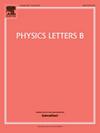通过神经网络驱动的微观计算揭示了BΛ12的超核团簇状态
IF 4.5
2区 物理与天体物理
Q1 ASTRONOMY & ASTROPHYSICS
引用次数: 0
摘要
我们使用神经网络驱动的微观模型研究BΛ12的超核簇态。我们扩展了控制神经网络(Control Neural Networks, Ctrl.NN)方法,系统地计算了BΛ12的正宇称谱。通过将sd-壳激发和奇偶耦合效应引入BΛ12超核系统,我们揭示了结构变化,包括聚类效应和新的构型,如等腰三角形和α-t-α线性链结构。此外,通过与实验数据进行比较,我们发现许多峰(#6和#8)可以解释为pΛ主导状态,这与壳模型预测一致。值得注意的是,根据我们对BΛ12激发态的分析,我们提出了以前无法解释或有争议的实验峰的可能候选点。本文章由计算机程序翻译,如有差异,请以英文原文为准。
Hypernuclear cluster states of BΛ12 unveiled through neural network-driven microscopic calculation
We investigate the hypernuclear cluster states of using a neural-network-driven microscopic model. We extend the Control Neural Networks (Ctrl.NN) method and systematically calculate the positive-parity spectrum of . By incorporating sd-shell excitations and parity-coupling effects into the hypernuclear system, we reveal structural changes, including clustering effects and new configurations such as isosceles-triangle and α-t-α linear-chain structures. Furthermore, by comparing with experimental data, we identify that many peaks (#6 and #8) can be interpreted as dominant states, which is consistent with shell-model predictions. Notably, based on our analysis of the excited states of , we propose possible candidates for previously unexplained or controversial experimental peaks.
求助全文
通过发布文献求助,成功后即可免费获取论文全文。
去求助
来源期刊

Physics Letters B
物理-物理:综合
CiteScore
9.10
自引率
6.80%
发文量
647
审稿时长
3 months
期刊介绍:
Physics Letters B ensures the rapid publication of important new results in particle physics, nuclear physics and cosmology. Specialized editors are responsible for contributions in experimental nuclear physics, theoretical nuclear physics, experimental high-energy physics, theoretical high-energy physics, and astrophysics.
 求助内容:
求助内容: 应助结果提醒方式:
应助结果提醒方式:


